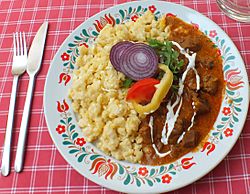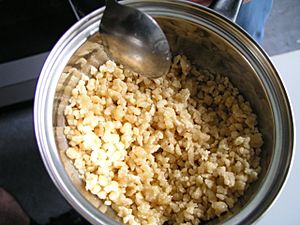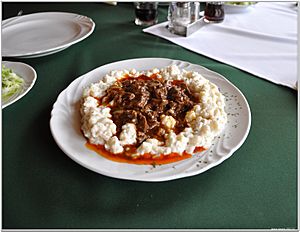Pörkölt facts for kids
 |
|
| Type | Stew |
|---|---|
| Place of origin | Hungary |
| Main ingredients | Meat, paprika, vegetables |
Pörkölt is a tasty meat stew that comes from Hungary. People enjoy this dish not only in Hungary but also in many other countries across Central Europe. It's a warm, hearty meal often made for families.
Contents
What is Pörkölt?
Pörkölt is a classic Hungarian stew. It is made with boneless meat, lots of paprika, and some vegetables. The word Pörkölt actually means "roasted" in Hungarian. This name comes from how the meat is cooked at the start.
Pörkölt, Goulash, and Paprikás: What's the Difference?
It can be easy to mix up Pörkölt with other Hungarian dishes like Goulash or Paprikás. But they are each special!
- Pörkölt is a stew with a thick sauce. It uses boneless meat and lots of paprika.
- Goulash is more like a soup. It has more liquid and often includes meat with bones. Goulash also has paprika, caraway seeds, vegetables, and sometimes potatoes or small dumplings.
- Paprikás is similar to Pörkölt but uses only meat and paprika. The big difference is that Paprikás always has thick, heavy sour cream added to make its sauce creamy.
These three dishes – Pörkölt, Paprikás, and Goulash – are all very important in Hungarian cooking. Many people think they are the national dishes of Hungary.
Pörkölt in Hungary
Pörkölt recipes can be a little different depending on where you are in Hungary. Most often, Pörkölt is made with beef or pork. But you can use almost any kind of meat! This includes lamb, chicken, or even wild game. Some people even make it with tripe (called pacalpörkölt) or liver.
If you don't eat meat, there's a version for you too! Gombapörkölt is a delicious Pörkölt made with mushrooms instead of meat.
Ingredients for Pörkölt
The main ingredients for Pörkölt are meat, onion, and sweet paprika powder. These three are the heart of the dish. Other ingredients are often added to make it even tastier. These can include tomatoes or tomato paste, green pepper, marjoram, and garlic. If fresh paprika powder isn't available, some cooks use fresh yellow Hungarian wax peppers instead.
How Pörkölt is Made
Making a good Pörkölt relies on using just a few high-quality ingredients. The flavor and spiciness of the paprika powder are super important for the taste.
Here's a simple Hungarian cooking tip for Pörkölt:
- First, the onions are fried in lard or oil.
- Then, the pot is taken off the heat.
- Right away, paprika powder and the meat are added. The mixture is stirred and "stir-fried." This step is where the word pörkölni (to roast) comes from. It helps keep the meat juicy.
- Finally, water is added, about the same amount as the meat. The stew is then simmered slowly with very little liquid.
It's important to know that flour is never used to thicken a traditional Hungarian Pörkölt.
Serving Pörkölt
In Hungary, Pörkölt is usually served with a side dish. Common choices include pasta (called tészta), tarhonya (which are large Hungarian pasta grains), or galuska/nokedli (small dumplings). Boiled potatoes are also a popular side. Many people like to eat pickles with Pörkölt. The sour taste of the pickles helps balance the rich flavor of the stew.
Pörkölt Around the World
Pörkölt is popular outside of Hungary too, often with some local twists.
Tokány: A Transylvanian Stew
There's a different style of Hungarian stew called tokány. This stew comes from Transylvania. Unlike Pörkölt, tokány doesn't use as much paprika. Instead, it often uses black pepper and other kitchen herbs like marjoram for flavor. Tokány can be made with different kinds of meat, vegetables, and wild mushrooms. It is often served with sour cream on top. Puliszka (polenta) or boiled potatoes are common side dishes.
Pörkölt in Other Countries
- In the Czech Republic, Pörkölt is made with pork, beer, dark bread, and caraway seeds. It's often served with large Czech knedlíky dumplings.
- In Slovakia, the dish is called perkelt. It is usually served with Halušky dumplings.
- In Poland, a dish similar to Hungarian Pörkölt is called Gulasz. It is very popular and usually eaten with potatoes.
See also
 In Spanish: Pörkölt para niños
In Spanish: Pörkölt para niños



